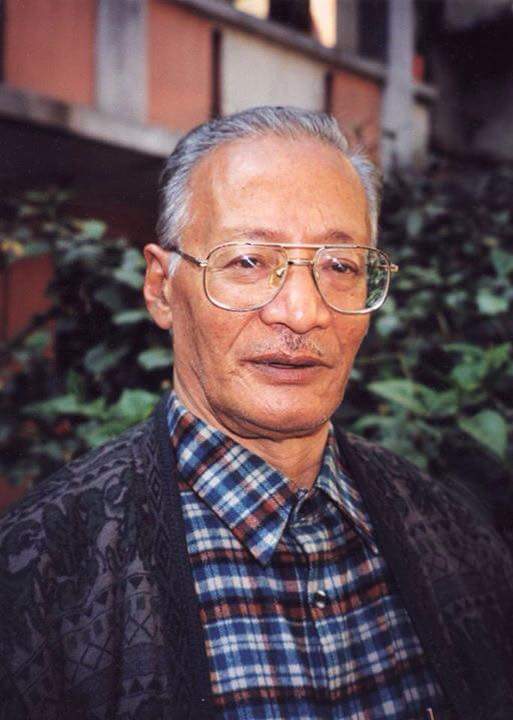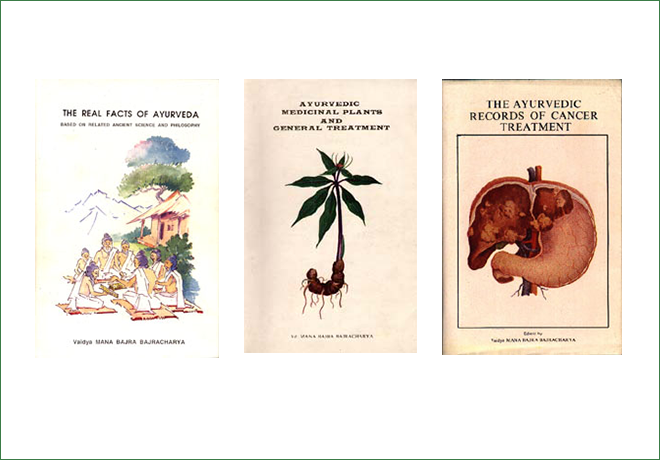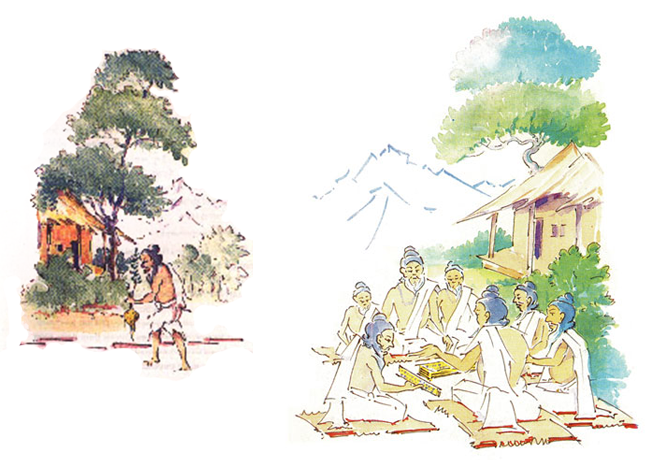
Early Life and Family Heritage
Dr. Mana Bajra Bajracharya, born February 1931 A.D., वि.सं १९८७ माघ, embarked on his remarkable journey in a distinguished family of Bajracharya, known for their Buddhist priesthood from Jana Bahal, Kanak Chaitya Mahavihar, Kathmandu Nepal. His early life was steeped in the traditions and practices of a family that had been upholding a prestigious Ayurvedic legacy for over 700 years. Under the guidance and mentorship of his father, Durga Bajra Bajracharya, his mother, Tirtha Kumari Bajracharya, and his grandfather, Nila Bajra Bajracharya, Dr. Mana was immersed in the rich heritage of Ayurvedic medicine from a young age.
In 1937, at the age of 6, marking a significant rite of passage, Dr. Mana received formal initiation as a Bajracharya, a crucial step towards becoming a member of the Kanak Chaitya Mahavihar, a Buddhist Great Monastery. This initiation was a testament to his deep-rooted connection to his cultural and religious heritage. Further solidifying his commitment to his spiritual path, in 1944, he received his consecration as Vajrayana, a necessary accomplishment to be recognized as an authorized Bajracharya.
Dr. Mana’s personal life was also intertwined with his spiritual practice. In 1945, he married Gyani Devi Bajracharya, embracing the Bajracharya tradition, which considers marriage essential for its practice. Together, they had one son Vaidya Madhu Bajra Bajracharya, and four daughters (Cham Bajracharya, Ali Bajracharya, Suravi Bajracharya, and Mallika Bajracharya), expanding the family lineage and continuing the rich cultural and spiritual traditions of the Bajracharya household. This period of Dr. Mana’s life laid the foundation for his future contributions to Ayurvedic medicine and his role as a custodian of his family’s legacy.
Formal Education and Training
Dr. Mana Bajra Bajracharya’s formal education and training were both extensive and profound, marking the beginning of his illustrious career in Ayurvedic medicine and Buddhist studies. At the young age of 17, he completed his formal education in Sanskrit, a significant milestone that laid the foundation for his future scholarly pursuits. Following this achievement, Dr. Mana delved deeply into the study of essential Ayurvedic texts, immersing himself in the Charaka Samhita, which focuses on internal medicine, the Susruta Samhita covering surgery, Madhava Nidana for diagnosis, Madanapala Nighantu emphasizing botany and pharmacology, and Rasatarangini, which deals with chemistry. This comprehensive study of Ayurvedic literature was paralleled by his dedicated exploration of Buddhism. Dr. Mana devoted himself to studying the original Mahayana Buddhist texts, including Naryakarana and others such as Pragyaparamita, Saddharma Pundarika, Lanka Valara, Dosha Bhumi, Gandavyuha, Samadhiraja, Suvarnaprabha Lahilaristara, and Guhya Samaja. For eight years, he continued this dual study, intertwining the rich teachings of Buddhism with the intricate science of Ayurveda, which not only broadened his intellectual horizons but also deeply influenced his holistic approach to health and wellbeing.
Exploration and Practical Learning
In 1955, Dr. Mana Bajra Bajracharya embarked on a transformative journey, one that would significantly enrich his understanding and practice of Ayurvedic medicine. He traveled across the diverse landscapes of Nepal and India, driven by a profound realization: to truly grasp the essence of Ayurveda, he needed to experience firsthand the growth and characteristics of medicinal plants in various climates. This two-year odyssey on foot was not just a physical journey but a quest for deeper knowledge. During this period, Dr. Mana dedicated himself to meticulously collecting almost all the plants mentioned in the Ayurvedic texts. His approach was unique and artistic – he didn’t just gather these plants; he also created on-the-spot color paintings of them, combining his scientific interests with his artistic talents. This blend of art and science enabled him to document the plants in a way that was both informative and visually engaging. After returning from this extensive exploration, Dr. Mana began treating patients independently, applying the rich insights and practical knowledge gained from his travels. This phase marked a crucial turning point in his career, as he transitioned from a student of Ayurveda to a practitioner, bringing his learning and observations to benefit those in need of healing.
Professional Milestones
Dr. Mana Bajra Bajracharya’s clinical practice and philosophical approach to medicine underwent significant development following his return from a comprehensive journey in Nepal and India. In 1969, he embarked on a new phase of his career, beginning to teach Buddhism and Ayurvedic medicine to Western students. This endeavor quickly garnered him widespread recognition and acclaim in Kathmandu, elevating his status not just as a physician but also as an educator and cultural ambassador.
His reputation soon crossed international borders. In 1972, Dr. Mana accepted an invitation to travel to Europe and the United States, a significant milestone that marked his first foray into the global arena. One of the highlights of this trip was his speech at Columbia University, where he shared his insights on Buddhism, further cementing his international standing as a scholar and practitioner.
Recognizing the growing interest in Ayurvedic medicine among the younger generation, Dr. Mana, upon his return, decided to expand his practice to cater to this new audience. He opened an examining room in his family ayurvedic clinic, Piyushabarsi Ausadhalaya, focusing especially on treating foreign patients. This strategic shift not only broadened his patient base but also allowed him to spread the knowledge and benefits of Ayurvedic medicine beyond his local community. Dr. Mana’s ability to blend traditional practices with contemporary needs showcased his adaptability and commitment to the holistic well-being of a diverse range of patients.
Contributions to Ayurveda and Buddhism
Dr. Mana Bajra Bajracharya’s contributions to Ayurveda and Buddhism are marked by his extensive authorship and dedicated teaching. He authored several influential books, significantly enriching the literature in these fields. “The Real Facts of Ayurveda” (1995) delves into the core aspects of Ayurvedic practice, covering its history, treatment methods, and foundational concepts. In “The Ayurvedic Records of Cancer Treatment” (1987), he addresses cancer treatment from an Ayurvedic perspective, offering valuable insights into alternative healing methodologies.
“The Eastern Theory of Diet” (1982) focuses on dietary practices and nutritional values from an Eastern viewpoint, highlighting the importance of diet in maintaining health and wellbeing. Another notable work, “Ayurvedic Medicinal Plants and General Treatment” (1979), provides comprehensive information on various Ayurvedic plants, including their descriptions, habitats, and medicinal uses.

In addition to his Ayurvedic works, Dr. Mana also made significant contributions to Buddhist literature. His book “Mythological History of the Nepal Valley from Svayambhu Purana” (1978), offers an in-depth exploration and the first English version of the Swayambhu Purana, shedding light on the origins of the revered Swayambhu Temple in Kathmandu, Nepal. Read here.
Dr. Mana Bajra Bajracharya’s literary contributions extended into the realm of cultural heritage, as evidenced by his noteworthy publications on Nepalese traditions. One such significant work is “Nepali Chad-Parbaharu Ko Bibechana,” a detailed exploration of the festivals of Nepal, providing insight into the country’s rich and diverse celebratory customs. Another notable publication, “Nepali Sanskriti Ko Paridhi” (1972), delves into the broader aspects of Nepali culture and heritage. This book offers a comprehensive look at the traditions, values, and historical underpinnings of Nepalese society, reflecting Dr. Mana’s deep commitment to preserving and sharing his country’s cultural legacy.
Beyond his written works, Dr. Mana was deeply committed to the promotion and teaching of both Ayurveda and Buddhism. His efforts in educating others, both within his community and internationally, have had a lasting impact, spreading the wisdom and practices of these ancient traditions to new generations and across cultural boundaries. His dedication to teaching has not only preserved these traditions but has also played a vital role in their evolution and contemporary relevance.
Personal Interests and Hobbies
Dr. Mana Bajra Bajracharya’s life was not solely defined by his professional achievements in Ayurveda and Buddhism; he also had a profound passion for the arts, particularly drawing and painting. His favorite subjects were nature scenes, capturing the serene beauty of the natural world in his artworks. This passion for art was not just a hobby; it seamlessly blended into his professional life as well. Dr. Mana skillfully incorporated his personal artwork into his published books, enriching his written works with visually engaging illustrations that reflected his deep connection to nature and his subjects.

Moreover, his interest in art extended to the creation of sculptures, particularly of body organs. These sculptures were not merely artistic expressions but also served as valuable educational tools in his teachings, helping students and practitioners of Ayurveda to better understand the human anatomy in a tangible and relatable way.
In addition to his artistic pursuits, Dr. Mana was dedicated to the research and study of ancient Ayurvedic medical scripts. He undertook the monumental task of translating these thousands of years old texts into English, thereby making this invaluable knowledge accessible to a global audience. His efforts in translation and sharing these ancient wisdoms played a crucial role in preserving and promoting Ayurveda beyond its traditional geographical and cultural boundaries. This unique blend of artistic talent and scholarly dedication highlighted Dr. Mana’s multifaceted personality and his commitment to sharing the rich heritage of Ayurvedic medicine with the world.
Legacy and Impact
Dr. Mana Bajra Bajracharya’s legacy in the field of Ayurvedic medicine and philosophy is both profound and enduring. Throughout his life, he played a pivotal role in preserving and enhancing the rich legacy of Ayurvedic practices. His dedication to maintaining authentic Ayurvedic treatment methods and upholding high standards of care has left an indelible mark on the practice of traditional medicine. Dr. Mana’s unwavering commitment to the authenticity of Ayurvedic principles ensured that this ancient form of healing continued to thrive and adapt in a modern context, bridging the gap between traditional wisdom and contemporary needs.
His death on Saturday 6 January 2001 A.D., वि.सं २०५७ पुष २२, at the age of 69, marked the end of an era but left behind a significant and impactful legacy. Dr. Mana’s contributions to Ayurvedic medicine and philosophy extended far beyond his lifetime, influencing future generations of practitioners and scholars. He is remembered not only for his deep knowledge and skill but also for his role in bringing Ayurveda to a wider audience, both in Nepal and internationally. His work has ensured that the invaluable insights and practices of Ayurveda continue to benefit people around the world, embodying a legacy that transcends time and geography. Dr. Mana Bajra Bajracharya’s life and work stand as a testament to the enduring value and relevance of Ayurvedic medicine in the contemporary world.
Conclusion
The life and work of Dr. Mana Bajra Bajracharya stand as a beacon of inspiration in the fields of Ayurvedic medicine and Buddhist philosophy. His enduring influence is a testament to his unique blend of traditional healing, academic rigor, and compassionate practice. Dr. Mana’s commitment to preserving and enhancing Ayurvedic traditions has not only contributed to the survival of this ancient practice but also to its thriving in the modern era. His approach to holistic health care, which combines a deep understanding of human nature with the meticulous study of Ayurveda and Buddhism, continues to influence practitioners and patients alike.
Dr. Mana’s legacy is further cemented by the continued efforts of his son, Vaidya Madhu Bajra Bajracharya, who carries forward the torch of Ayurvedic research, treatment, and holistic approach. Through Madhu’s work, the essence of Dr. Mana’s teachings and practices continues to benefit and inspire new generations. Dr. Mana Bajra Bajracharya’s life story is not just a chronicle of personal achievements; it is a narrative that intertwines the preservation of cultural heritage with the advancement of holistic health care, leaving an indelible mark on the world of medicine and spirituality.
